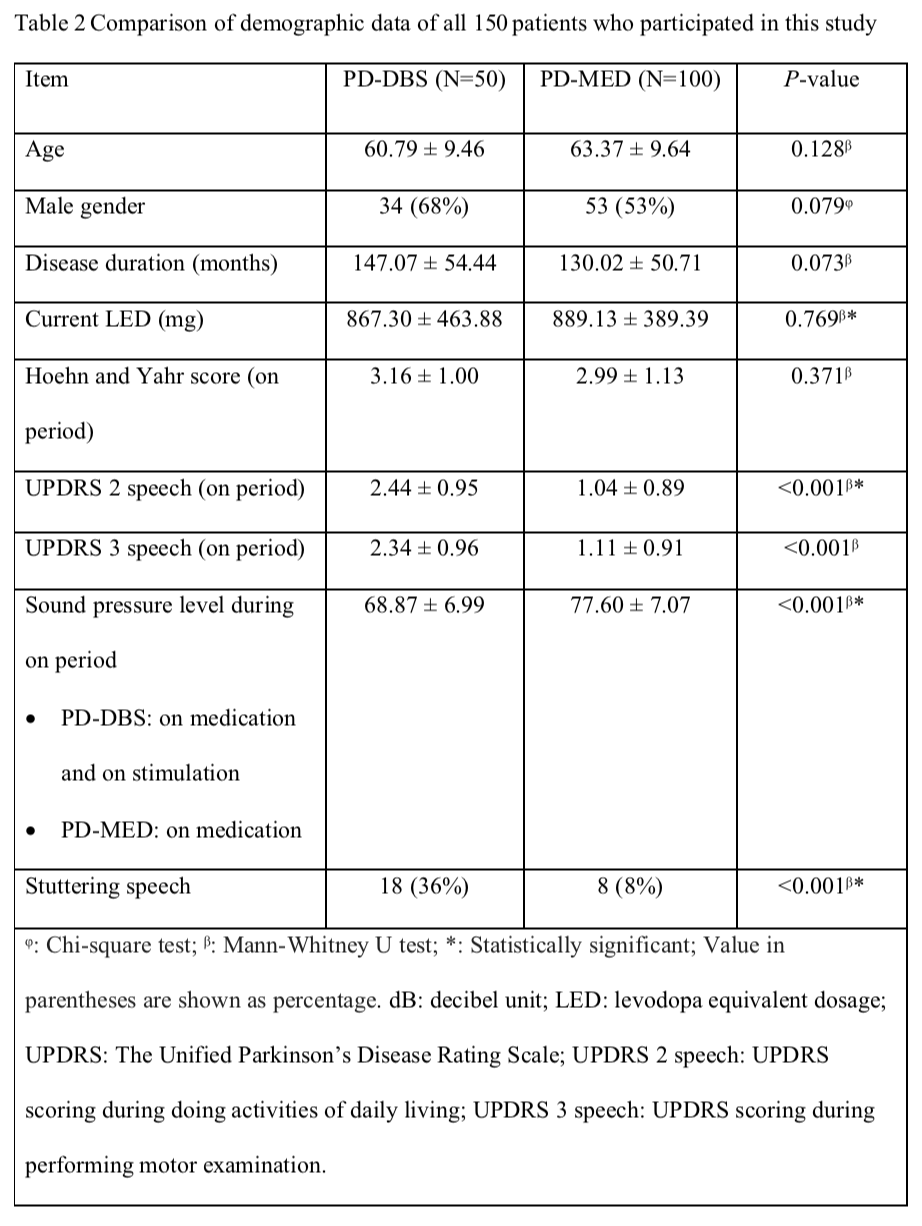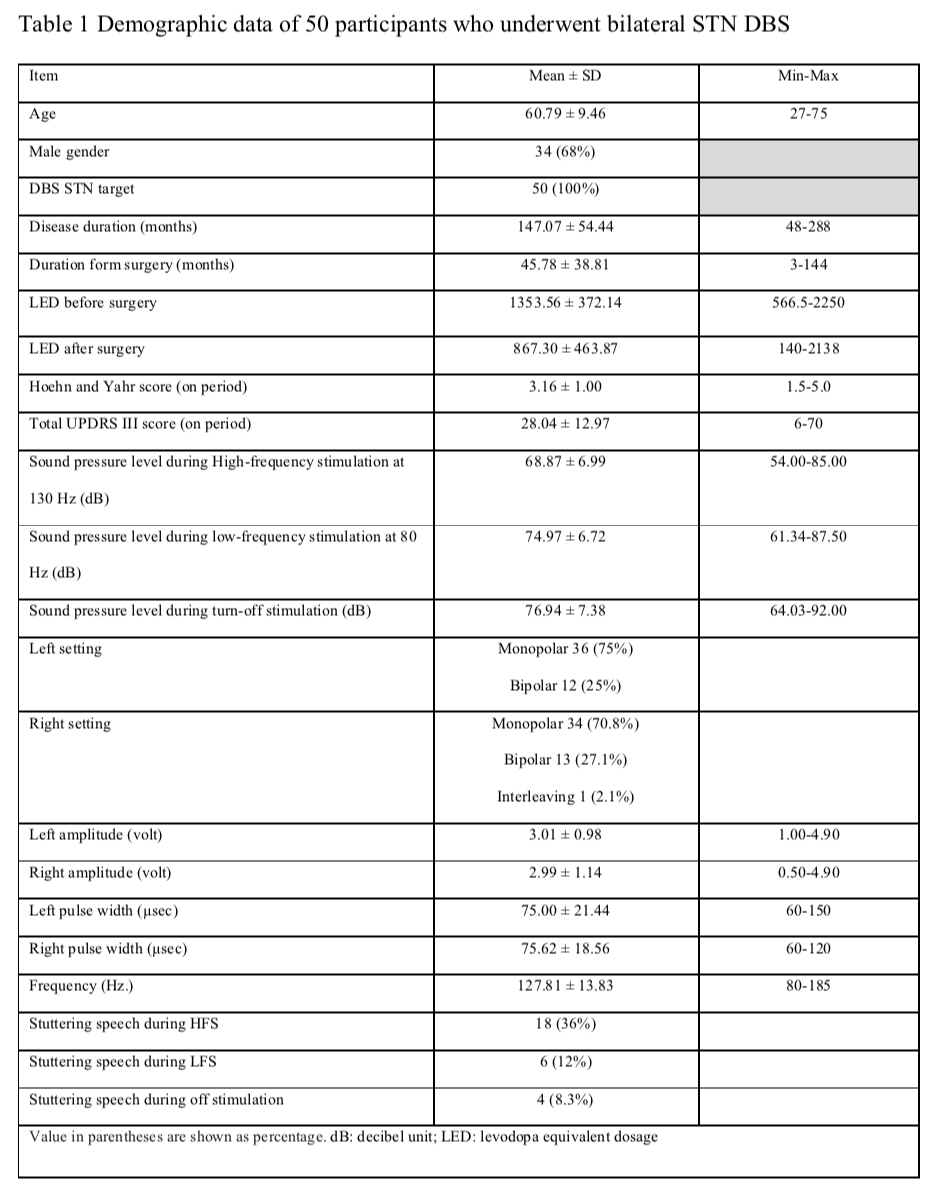Session Information
Date: Tuesday, September 24, 2019
Session Title: Parkinsonisms and Parkinson-Plus
Session Time: 1:45pm-3:15pm
Location: Agora 3 West, Level 3
Objective: This study aimed to identify the prevalence of speech problems including stuttering and hypophonia in patients with Parkinson’s disease (PD). Participants with or without bilateral STN-DBS were compared to determine the effects of low-frequency stimulation (LFS) and the influence of the contact location on speech problems.
Background: Speech disorders including stuttering and hypophonia have been reported after subthalamic deep brain stimulation (STN-DBS). LFS or a change in the electrode contact position may improve speech functions.
Method: For this case-controlled study, we enrolled 50 PD patients with, and 100 PD patients without, STN-DBS. Only clinically meaningful stuttering was taken into consideration. Voice levels were objectively measured. For patients with STN-DBS, stuttering, sound pressure, and UPDRS speech sections were compared for high-frequency (130 Hz), low-frequency (80 Hz), and off stimulation.
Results: There were no statistically significant differences between patients with STN-DBS and medically treated patients regarding age, sex, disease duration, and H&Y score (all p>0.05). Stuttering, sound pressure level, and UPDRS speech section score were worse in patients with STN-DBS compared to those without (all p<0.05). High-frequency stimulation (HFS) resulted in lower sound pressure values compared to LFS and off stimulation (both p<0.05), and also increased the scores for the daily living and motor section (both p<0.05, UPDRS speech sections) compared to LFS. The level of stuttering was increased in patients with STN-DBS (36%) compared to those without (8%, p<0.05).Stuttering was present in 36% of the study population during HFS, but only in 12% during LFS and in 8% during off stimulation.Active dorsal contacts resulted in a lower speech volume compared to ventral contacts (p<0.05).
Conclusion: STN-DBS at high frequency and with dorsal contacts can aggravate certain speech problems. Maintaining the balance between parkinsonian control and speech problems is important in these patients.
References: 1. Toft M, Dietrichs E. Aggravated stuttering following subthalamic deep brain stimulation in Parkinson’s disease–two cases. BMC Neurol. 2011;11:44. 2. Di Biase L, Fasano A. Low-frequency deep brain stimulation for Parkinson’s disease: Great expectation or false hope? Mov Disord. 2016;31(7):962-7. 3. Xie T, Padmanaban M, Bloom L, MacCracken E, Bertacchi B, Dachman A, et al. Effect of low versus high frequency stimulation on freezing of gait and other axial symptoms in Parkinson patients with bilateral STN DBS: a mini-review. Transl Neurodegener. 2017;6:13.
To cite this abstract in AMA style:
O. Phokaewvarangkul, K. Boonpang, R. Bhidayasiri. Stimulation Frequency and Active Contact Location Influence Speech Problems in Parkinson’s Disease Patients with Bilateral Subthalamic Deep Brain Stimulation [abstract]. Mov Disord. 2019; 34 (suppl 2). https://www.mdsabstracts.org/abstract/stimulation-frequency-and-active-contact-location-influence-speech-problems-in-parkinsons-disease-patients-with-bilateral-subthalamic-deep-brain-stimulation/. Accessed December 27, 2025.« Back to 2019 International Congress
MDS Abstracts - https://www.mdsabstracts.org/abstract/stimulation-frequency-and-active-contact-location-influence-speech-problems-in-parkinsons-disease-patients-with-bilateral-subthalamic-deep-brain-stimulation/


